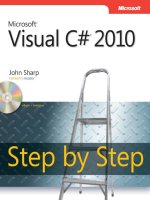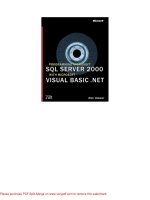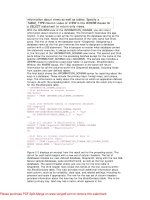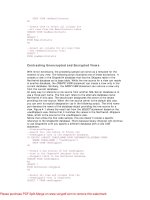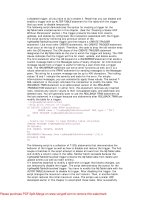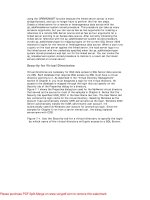C++ AMP: Accelerated Massive Parallelism with Microsoft Visual C++ potx
Bạn đang xem bản rút gọn của tài liệu. Xem và tải ngay bản đầy đủ của tài liệu tại đây (16.99 MB, 356 trang )
www.it-ebooks.info
www.it-ebooks.info
C++ AMP: Accelerated
Massive Parallelism with
Microsoft
®
Visual C++
®
Kate Gregory
Ade Miller
www.it-ebooks.info
Published with the authorization of Microsoft Corporation by:
O’Reilly Media, Inc.
1005 Gravenstein Highway North
Sebastopol, California 95472
Copyright © 2012 by Ade Miller, Gregory Consulting Limited
All rights reserved. No part of the contents of this book may be reproduced or transmitted in any form or by any
means without the written permission of the publisher.
ISBN: 978-0-7356-6473-9
1 2 3 4 5 6 7 8 9 LSI 7 6 5 4 3 2
Printed and bound in the United States of America.
Microsoft Press books are available through booksellers and distributors worldwide. If you need support related
to this book, email Microsoft Press Book Support at Please tell us what you think of
this book at
Microsoft and the trademarks listed at />Trademarks/EN-US.aspx are trademarks of the Microsoft group of companies. All other marks are property of
their respective owners.
The example companies, organizations, products, domain names, email addresses, logos, people, places, and
events depicted herein are ctitious. No association with any real company, organization, product, domain name,
email address, logo, person, place, or event is intended or should be inferred.
This book expresses the author’s views and opinions. The information contained in this book is provided without
any express, statutory, or implied warranties. Neither the authors, O’Reilly Media, Inc., Microsoft Corporation,
nor its resellers, or distributors will be held liable for any damages caused or alleged to be caused either directly
or indirectly by this book.
Acquisitions and Developmental Editor: Russell Jones
Production Editor: Holly Bauer
Editorial Production: nSight, Inc.
Copyeditor: nSight, Inc.
Indexer: nSight, Inc.
Cover Design: Twist Creative • Seattle
Cover Composition: Zyg Group, LLC
Illustrator: Rebecca Demarest
www.it-ebooks.info
Dedicated to Brian, who has always been my secret weapon,
and my children, now young adults who think it’s normal for your
mum to write books.
—Kate GreGory
Dedicated to The Susan,
who is so much more than I deserve.
—ade Miller
www.it-ebooks.info
www.it-ebooks.info
Contents at a Glance
Foreword xv
Introduction xvii
CHAPTER 1 Overview and C++ AMP Approach 1
CHAPTER 2 NBody Case Study 21
CHAPTER 3 C++ AMP Fundamentals 45
CHAPTER 4 Tiling 63
CHAPTER 5 Tiled NBody Case Study 83
CHAPTER 6 Debugging 101
CHAPTER 7 Optimization 127
CHAPTER 8 Performance Case Study—Reduction 171
CHAPTER 9 Working with Multiple Accelerators 203
CHAPTER 10 Cartoonizer Case Study 223
CHAPTER 11 Graphics Interop 257
CHAPTER 12 Tips, Tricks, and Best Practices 283
APPENDIX Other Resources 309
Index 313
About the Authors 327
www.it-ebooks.info
www.it-ebooks.info
vii
Contents
Foreword xv
Introduction xvii
Chapter 1 Overview and C++ AMP Approach 1
Why GPGPU? What Is Heterogeneous Computing? 1
History of Performance Improvements 1
Heterogeneous Platforms 2
GPU Architecture 4
Candidates for Performance Improvement through Parallelism 5
Technologies for CPU Parallelism 8
Vectorization 8
OpenMP 10
Concurrency Runtime (ConcRT) and Parallel Patterns Library 11
Task Parallel Library 12
WARP—Windows Advanced Rasterization Platform 12
Technologies for GPU Parallelism 13
Requirements for Successful Parallelism 14
The C++ AMP Approach 15
C++ AMP Brings GPGPU (and More) into the Mainstream 15
C++ AMP Is C++, Not C 16
C++ AMP Leverages Tools You Know 16
C++ AMP Is Almost All Library 17
C++ AMP Makes Portable, Future-Proof Executables 19
Summary. . . . . . . . . . . . . . . . . . . . . . . . . . . . . . . . . . . . . . . . . . . . . . . . . . . . . . . .20
Chapter 2 NBody Case Study 21
Prerequisites for Running the Example 21
Running the NBody Sample 22
Structure of the Example 28
www.it-ebooks.info
viii Contents
CPU Calculations 29
Data Structures 29
The wWinMain Function 30
The OnFrameMove Callback 30
The OnD3D11CreateDevice Callback 31
The OnGUIEvent Callback 33
The OnD3D11FrameRender Callback 33
The CPU NBody Classes 34
NBodySimpleInteractionEngine 34
NBodySimpleSingleCore 35
NBodySimpleMultiCore 35
NBodySimpleInteractionEngine::BodyBodyInteraction 35
C++ AMP Calculations 36
Data Structures 37
CreateTasks 38
The C++ AMP NBody Classes 40
NBodyAmpSimple::Integrate 40
BodyBodyInteraction 41
Summary. . . . . . . . . . . . . . . . . . . . . . . . . . . . . . . . . . . . . . . . . . . . . . . . . . . . . . . .43
Chapter 3 C++ AMP Fundamentals 45
array<T, N> 45
accelerator and accelerator_view 48
index<N> 50
extent<N> 50
array_view<T, N> 51
parallel_for_each 55
Functions Marked with restrict(amp) 57
Copying between CPU and GPU 59
Math Library Functions 61
Summary. . . . . . . . . . . . . . . . . . . . . . . . . . . . . . . . . . . . . . . . . . . . . . . . . . . . . . . .62
www.it-ebooks.info
Contents ix
Chapter 4 Tiling 63
Purpose and Benet of Tiling 64
tile_static Memory 65
tiled_extent 66
tiled_index<N1, N2, N3> 67
Modifying a Simple Algorithm into a Tiled One 68
Using tile_static memory 70
Tile Barriers and Synchronization 74
Completing the Modication of Simple into Tiled 76
Effects of Tile Size 77
Choosing Tile Size 79
Summary 81
Chapter 5 Tiled NBody Case Study 83
How Much Does Tiling Boost Performance for NBody? 83
Tiling the n-body Algorithm 85
The NBodyAmpTiled Class 85
NBodyAmpTiled::Integrate. . . . . . . . . . . . . . . . . . . . . . . . . . . . . . . . . . . .86
Using the Concurrency Visualizer 90
Choosing Tile Size 95
Summary. . . . . . . . . . . . . . . . . . . . . . . . . . . . . . . . . . . . . . . . . . . . . . . . . . . . . . . .99
Chapter 6 Debugging 101
First Steps 101
Choosing GPU or CPU Debugging 102
The Reference Accelerator 106
GPU Debugging Basics 108
Familiar Windows and Tips 108
The Debug Location Toolbar 109
Detecting Race Conditions 110
www.it-ebooks.info
x Contents
Seeing Threads 112
Thread Markers. . . . . . . . . . . . . . . . . . . . . . . . . . . . . . . . . . . . . . . . . . . .113
GPU Threads Window 113
Parallel Stacks Window 115
Parallel Watch Window 117
Flagging, Grouping, and Filtering Threads 119
Taking More Control 121
Freezing and Thawing Threads 121
Run Tile to Cursor 123
Summary 125
Chapter 7 Optimization 127
An Approach to Performance Optimization 127
Analyzing Performance 128
Measuring Kernel Performance 129
Using the Concurrency Visualizer 131
Using the Concurrency Visualizer SDK 137
Optimizing Memory Access Patterns 138
Aliasing and parallel_for_each Invocations 138
Efcient Data Copying to and from the GPU 141
Efcient Accelerator Global Memory Access 146
Array of Structures vs. Structure of Arrays 149
Efcient Tile Static Memory Access 152
Constant Memory 155
Texture Memory 156
Occupancy and Registers 157
Optimizing Computation 158
Avoiding Divergent Code 158
Choosing the Appropriate Precision 161
Costing Mathematical Operations 163
Loop Unrolling 164
Barriers 165
Queuing Modes 168
Summary. . . . . . . . . . . . . . . . . . . . . . . . . . . . . . . . . . . . . . . . . . . . . . . . . . . . . . .169
www.it-ebooks.info
Contents xi
Chapter 8 Performance Case Study—Reduction 171
The Problem 171
A Small Disclaimer 172
Case Study Structure 172
Initializations and Workload 174
Concurrency Visualizer Markers 175
TimeFunc() 176
Overhead 178
CPU Algorithms 178
Sequential 178
Parallel 179
C++ AMP Algorithms 179
Simple 180
Simple with array_view 182
Simple Optimized 183
Naïvely Tiled 185
Tiled with Shared Memory 187
Minimizing Divergence 192
Eliminating Bank Conicts 193
Reducing Stalled Threads 194
Loop Unrolling 195
Cascading Reductions 198
Cascading Reductions with Loop Unrolling 200
Summary 201
Chapter 9 Working with Multiple Accelerators 203
Choosing Accelerators 203
Using More Than One GPU 208
Swapping Data among Accelerators 211
Dynamic Load Balancing 216
Braided Parallelism 219
Falling Back to the CPU 220
Summary. . . . . . . . . . . . . . . . . . . . . . . . . . . . . . . . . . . . . . . . . . . . . . . . . . . . . . .222
www.it-ebooks.info
xii Contents
Chapter 10 Cartoonizer Case Study 223
Prerequisites 224
Running the Sample 224
Structure of the Sample 228
The Pipeline 229
Data Structures 229
The CartoonizerDlg::OnBnClickedButtonStart() Method 231
The ImagePipeline Class 232
The Pipeline Cartoonizing Stage 236
The ImageCartoonizerAgent Class 236
The IFrameProcessor Implementations 239
Using Multiple C++ AMP Accelerators 246
The FrameProcessorAmpMulti Class 246
The Forked Pipeline 249
The ImageCartoonizerAgentParallel Class 250
Cartoonizer Performance 252
Summary. . . . . . . . . . . . . . . . . . . . . . . . . . . . . . . . . . . . . . . . . . . . . . . . . . . . . . .255
Chapter 11 Graphics Interop 257
Fundamentals 257
norm and unorm 258
Short Vector Types 259
texture<T, N> 262
writeonly_texture_view<T, N> 269
Textures vs. Arrays 270
Using Textures and Short Vectors 271
HLSL Intrinsic Functions 274
DirectX Interop 275
Accelerator View and Direct3D Device Interop 276
Array and Direct3D Buffer Interop 277
Texture and Direct3D Texture Resource Interop 277
Using Graphics Interop 280
Summary. . . . . . . . . . . . . . . . . . . . . . . . . . . . . . . . . . . . . . . . . . . . . . . . . . . . . . .282
www.it-ebooks.info
Contents xiii
Chapter 12 Tips, Tricks, and Best Practices 283
Dealing with Tile Size Mismatches 283
Padding Tiles 285
Truncating Tiles 286
Comparing Approaches 290
Initializing Arrays 290
Function Objects vs. Lambdas 291
Atomic Operations 292
Additional C++ AMP Features on Windows 8 295
Time-Out Detection and Recovery 296
Avoiding TDRs. . . . . . . . . . . . . . . . . . . . . . . . . . . . . . . . . . . . . . . . . . . . .297
Disabling TDR on Windows 8 297
Detecting and Recovering from a TDR 298
Double-Precision Support 299
Limited Double Precision 300
Full Double Precision 300
Debugging on Windows 7 300
Congure the Remote Machine 301
Congure Your Project 301
Deploy and Debug Your Project 302
Additional Debugging Functions 302
Deployment 303
Deploying your Application 303
Running C++ AMP on Servers 304
C++ AMP and Windows 8 Windows Store Apps 306
Using C++ AMP from Managed Code 306
From a .NET Application, Windows 7 Windows Store
App or Library 306
From a C++ CLR Application 307
From within a C++ CLR Project 307
Summary. . . . . . . . . . . . . . . . . . . . . . . . . . . . . . . . . . . . . . . . . . . . . . . . . . . . . . .307
www.it-ebooks.info
xiv Contents
Appendix Other Resources 309
More from the Authors 309
Microsoft Online Resources 309
Download C++ AMP Guides 309
Code and Support 310
Training 311
Index 313
About the Authors 327
What do you think of this book? We want to hear from you!
Microsoft is interested in hearing your feedback so we can continually improve our
books and learning resources for you. To participate in a brief online survey, please visit:
microsoft.com/learning/booksurvey
www.it-ebooks.info
xv
Foreword
F
or most of computing history, we beneted from exponential increases in perfor-
mance of scalar processors. That has come to an end. We are now at the dawn of
the heterogeneous parallel computing era. With all applications being power-sensitive
and all computing systems being power-limited, from mobile to cloud, future comput-
ing platforms must embrace heterogeneity. For example, a fast-growing portion of the
top supercomputers in the world have become heterogeneous CPU + GPU computing
clusters. While the rst-generation programming interfaces such as CUDA and OpenCL
have enabled development of new libraries and applications for these systems, there
has been a clear need for much higher productivity in heterogeneous parallel software
development.
The major challenge is that any programming interface that raises productivity in
this domain must also give programmers enough control to reach their performance
goals. C++ AMP from Microsoft is a major step forward in addressing this challenge.
The C++ AMP interface is a simple, elegant extension to the C++ language to address
two major weaknesses of previous interfaces. First, the previous approaches did not
t well with the C++ software engineering practice. The kernel-based parallel pro-
gramming models tend to disturb the class organization of applications. Second, their
C-based indexing for dynamically allocated arrays complicates the code for managing
locality.
I am excited to see that C++ AMP supports the use of C++ loop constructs and
objected-oriented features in parallel code to address the rst issue and an array_view
construct to address the second issue. The array_view approach is forward-looking and
prepares applications to take full advantage of the upcoming unied address space
architectures. Many experienced CUDA and OpenCL programmers have found the
C++ AMP programming style refreshing, elegant, and effective.
Equally importantly, in my opinion, the C++ AMP interface opens the door for a
wide range of innovative compiler transformations, such as data layout adjustment and
thread granularity adjustment, to become mainstream. It also enables run-time imple-
mentation optimizations on data movement. Such advancements will be needed for a
dramatic improvement in programmer productivity.
While C++ AMP is currently only implemented on Windows, the interface is open
and will likely be implemented on other platforms. There is great potential for the
C++ AMP interface to make an even bigger impact if and when the other platform
vendors begin to offer their implementation of the interface.
www.it-ebooks.info
xvi Foreword
This book’s publication marks an important milestone in heterogeneous parallel
computing. With this book, I expect to see many more developers who can produc-
tively develop heterogeneous parallel applications. I am honored to write this foreword
and be part of this great movement. More important, I salute the C++ AMP engineer-
ing team at Microsoft who labored to make this advancement possible.
Wen-mei W. Hwu
Professor and Sanders-AMD Chair in ECE,
University of Illinois at Urbana-Champaign
CTO, MulticoreWare, Inc.
www.it-ebooks.info
Introduction xvii
Introduction
C
++ Accelerated Massive Parallelism (C++ AMP) is Microsoft’s technology for
accelerating C++ applications by allowing code to run on data-parallel hardware
like graphics-processing units (GPUs.) It’s intended not only to address today’s parallel
hardware in the form of GPUs and APUs, but also to future-proof your code invest-
ments by supporting new parallel hardware in the future. C++ AMP is also an open
specication. Microsoft’s implementation is built on top of DirectX, enabling portability
across different hardware platforms. Other implementations can build on other tech-
nologies because the specication makes no requirement for DirectX.
The C++ AMP programming model comprises a modern C++ STL-like template
library and two extensions to the C++ language that are integrated into the Visual
C++ 2012 compiler. It’s also fully supported by the Visual Studio toolset with Intelli-
Sense editing, debugging, and proling. C++ AMP brings the performance of heteroge-
neous hardware into the mainstream and lowers the barrier to entry for programming
such systems without affecting your productivity.
This book shows you how to take advantage of C++ AMP in your applications. In
addition to describing the features of C++ AMP, the book also contains several case
studies that show realistic implementations of applications with various approaches to
implementing some common algorithms. You can download the full source for these
case studies and the sample code from each chapter and explore them for yourself.
Who Should Read This Book
This book’s goal is to help C++ developers understand C++ AMP, from the core
concepts to its more advanced features. If you are looking to take advantage of hetero-
geneous hardware to improve the performance of existing features within your applica-
tion or add entirely new ones that were previously not possible due to performance
limitations, then this book is for you.
After reading this book you should understand the best way to incorporate
C++ AMP into your application where appropriate. You should also be able to use the
debugging and proling tools in Microsoft Visual Studio 2012 to troubleshoot issues
and optimize performance.
www.it-ebooks.info
xviii Introduction
Assumptions
This book expects that you have at least a working understanding of Windows C++ de-
velopment, object-oriented programming concepts, and the C++ Standard Library
(often called the STL after its predecessor, the Standard Template Library.) Familiarity
with general parallel processing concepts is also helpful but not essential. Some of the
samples use DirectX, but you don’t need to have any DirectX background to use the
samples or to understand the C++ AMP code in them.
For a general introduction to the C++ language, consider reading Bjarne Stroustrup’s
The C++ Programming Language (Addison-Wesley, 2000). This book makes use of
many new language and library features in C++11, which is so new that at the time of
press there are few resources covering the new features. Scott Meyers’s Presentation
Materials: Overview of the New C++ (C++11) provides a good overview. You can pur-
chase it online from Artima Developer, />new_cpp. Nicolai M. Josuttis’s The C++ Standard Library: A Tutorial and Reference (2nd
Edition) (Addison-Wesley Professional, 2012) is a good introduction to the Standard
Library.
The samples in this book also make extensive use of the Parallel Patterns Library
and the Asynchronous Agents Library. Parallel Programming with Microsoft Visual
C++ ( Microsoft Press, 2011), by Colin Campbell and Ade Miller, is a good introduction
to both libraries. This book is also available free from MSDN, />en-us/library/gg675934.aspx.
Who Should Not Read This Book
This book isn’t intended to teach you C++ or the Standard Library. It assumes a working
knowledge of both the language and the library. This book is also not a general intro-
duction to parallel programming or even multithreaded programming. If you are not
familiar with these topics, you should consider reading some of the books referenced in
the previous section.
Organization of This Book
This book is divided into 12 chapters. Each focuses on a different aspect of program-
ming with C++ AMP. In addition to chapters on specic aspects of C++ AMP, the book
also includes three case studies designed to walk through key C++ AMP features used
www.it-ebooks.info
Introduction xix
in real working applications. The code for each of the case studies, along with the
samples shown in the other chapters, is available for download on CodePlex.
Chapter 1
Overview and C++ AMP Approach
An introduction to GPUs, heterogeneous computing, paral-
lelism on the CPU, and how C++ AMP allows applications to
harness the power of today’s heterogeneous systems.
Chapter 2
NBody Case Study
Implementing an n-body simulation using C++ AMP.
Chapter 3
C++ AMP Fundamentals
A summary of the library and language changes that make up
C++ AMP and some of the rules your code must follow.
Chapter 4
Tiling
An introduction to tiling, which breaks a calculation into
groups of threads called tiles that can share access to a very
fast programmable cache.
Chapter 5
Tiled NBody Case Study
An explanation of the tiled version of the NBody sample de-
scribed in Chapter 2.
Chapter 6
Debugging
A review of the techniques and tools for debugging a
C++ AMP application in Visual Studio.
Chapter 7
Optimization
More details on the factors that affect performance of a
C++ AMP application, on how to measure performance, and
on how to adjust your code to get the maximum speed.
Chapter 8
Performance Case Study—Reduction
A review of a single simple calculation implemented in a vari-
ety of ways and the performance changes brought about by
each implementation change.
Chapter 9
Working with Multiple Accelerators
How to take advantage of multiple GPUs for maximum per-
formance, braided parallelism, and using the CPU to ensure
that you use the GPU as efciently as possible.
Chapter 10
Cartoonizer Case Study
An explanation of a complex sample that combines CPU
parallelism with C++ AMP parallelism and supports multiple
accelerators.
Chapter 11
Graphics Interop
Using C++ AMP in conjunction with DirectX.
Chapter 12
Tips, Tricks, and Best Practices
Instructions on how to deal with less common situations and
environments and to overcome some common problems.
Appendix
Other Resources
Online resources, support, and training for those who want to
learn even more about C++ AMP.
Conventions and Features in This Book
This book presents information using conventions designed to make the information
readable and easy to follow.
Boxed elements with labels such as “Note” provide additional information or
alternative methods for completing a step.
www.it-ebooks.info
xx Introduction
A plus sign (+) between two key names means that you must press those keys
at the same time. For example, “Press Alt+Tab” means that you hold down the
Alt key while you press the Tab key.
A vertical bar between two or more menu items (for example, File | Close),
means that you should select the rst menu or menu item, then the next, and
so on.
System Requirements
You will need the following hardware and software to build and run the samples in this
book:
Either Microsoft Windows 7 with Service Pack 1 or Windows 8 (x86 or x64).
The samples should also build and run on Windows Server 2008 R2 (x64) and
Windows Server 2012 (x64), but they have not been tested on these OSs.
Visual Studio 2012, any edition (the Professional or Ultimate product is required
to walk through the proling examples in chapters 7 and 8).
The DirectX SDK (June 2010) is required to build the NBody case study.
A computer that has a 1.6GHz or faster processor. A four-core processor is
recommended.
1 GB (32-bit) or 2 GB (64-bit) RAM.
10 GB of available hard disk space (for installing Visual Studio 2012).
5400 RPM hard disk drive.
A DirectX 11 capable video card (for the C++ AMP samples) running at 1024 x
768 or higher-resolution display (for Visual Studio 2012).
A DVD-ROM drive (if installing Visual Studio 2012 from a DVD).
An Internet connection to download software or chapter examples.
www.it-ebooks.info
Introduction xxi
Code Samples
Most of the chapters in this book include samples that let you interactively try out new
material learned in the main text. The working examples can be seen on the web at:
/>Follow the instructions to download the source zip le.
Note In addition to the code samples, your system should have Visual Studio
2012 and the DirectX SDK (June 2010) installed. If they’re available, install the
latest service packs for each product.
Installing the Code Samples
Follow these steps to install the code samples on your computer:
1. Download the source zip le from the book’s CodePlex website, http://ampbook
.codeplex.com/. You can nd the latest download on the Downloads tab. Choose
the most recent recommended download.
2. If prompted, review the displayed end user license agreement. If you accept the
terms, choose the Accept option and then click Next.
3. Unzip the le into a folder and open the BookSamples.sln le using Visual
Studio 2012.
Note If the license agreement doesn’t appear, you can access it from the
CodePlex site, A copy is also included
with the sample code.
www.it-ebooks.info
xxii Introduction
Using the Code Samples
The Samples folder that’s created by unzipping the sample download contains three
subfolders:
CaseStudies This folder contains the three case studies described in chapters
2, 8, and 10. Each case study has a separate folder:
NBody An n-body gravitational model
Reduction A series of implementations of the reduce algorithm designed
to show performance tradeoffs
Cartoonizer An image-processing application that cartoonizes sequences
of images either loaded from disk or captured by a video camera
Chapter 4, 7, 9, 11, 12 Folders containing the code that accompanies the
corresponding chapters.
ShowAmpDevices A small utility application that lists the C++ AMP-capable
devices present on the host computer.
The top-level Samples folder contains a Visual Studio 2012 solution le, Book-
Samples.sln. This contains all the projects listed above. It should compile with no warn-
ings or errors in Debug and Release congurations and can target both Win32 and x64
platforms. Each of the projects also has its own solution le, should you wish to load
them separately.
Acknowledgments
No book is the effort of any one person. This book has two authors, but many others
helped along the way. The authors would like to thank the following people:
The C++ AMP product team at Microsoft who went above and beyond to provide
review feedback on draft chapters and answered numerous questions; Amit Agarwal,
David Callahan, Charles Fu, Jerry Higgins, Yossi Levanoni, Don McCrady, Łukasz Menda-
kiewicz, Daniel Moth, Bharath Mysore Nanjundappa, Pooja Nagpal, James Rapp, Simon
Wybranski, Lingli Zhang, and Weirong Zhu (Microsoft Corporation).
The C++ AMP team also maintains a blog that provided invaluable source material.
Many of the reviewers from the C++ AMP product team listed above also wrote those
posts. In addition, the following also wrote material we found particularly helpful: Steve
www.it-ebooks.info
Introduction xxiii
Deitz, Kevin Gao, Pavan Kumar, Paul Maybee, Joe Mayo, and Igor Ostrovsky (Microsoft
Corporation.)
Ed Essey and Daniel Moth (Microsoft Corporation) were instrumental in getting the
whole project started and approaching O’Reilly and the authors with the idea of a book
about C++ AMP. They also coordinated our work with the C++ AMP product team.
Thank you also Russell Jones and Holly Bauer and Carol Whitney, who handled copy-
editing and production, and Rebecca Demarest, the technical illustrator.
We were also lucky enough to be able to circulate early drafts of the book on Safari
through O’Reilly’s Rough Cuts program. Many people provided feedback on these early
drafts. We would like to thank them for their time and interest. Bruno Boucard and
Veikko Eeva have been particularly helpful and enthusiastic reviewers.
Errata & Book Support
We’ve made every effort to ensure the accuracy of this book and its companion con-
tent. Any errors that have been reported since this book was published are listed on our
Microsoft Press site at oreilly.com:
If you nd an error that is not already listed, you can report it to us through the
same page.
If you need additional support, e-mail Microsoft Press Book Support at mspinput@
microsoft.com.
Please note that product support for Microsoft software is not offered through the
addresses above.
We Want to Hear from You
At Microsoft Press, your satisfaction is our top priority, and your feedback our most
valuable asset. Please tell us what you think of this book at:
/>The survey is short, and we read every one of your comments and ideas. Thanks in
advance for your input!
www.it-ebooks.info

